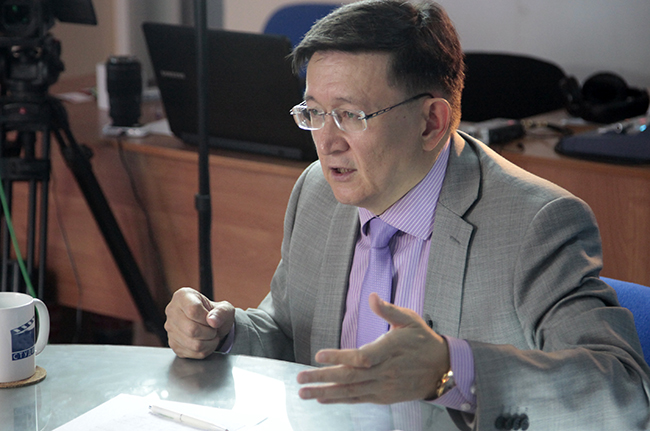News that Unified Accumulative Fund of Kazakhstan has invested 71.3 bil. tenge into bonds of International bank of Azerbaijan, which at present has serious problems, literally shocked the participants of the financial markets and the experts. What is it – foolishness, professionalism or coruption? And is there a chance to get this money back?
Kazakhstani economist and former government official R. Oshakbaev has focused our attention on the subject. Having noticed shocking numbers in the report of UAPF from May 1st 2017 he wrote on Facebook: “Very indicative: investments come into the same bank but results are oppositely different. HalykBank sold bonds of the problematic Azerbaijani bank back in 2014, seeing obvious signs of worsening of its financing. National bank on the other hand, in Oct. 2014 buys risky bonds for pension money bonds of that same bank. HalykBank, in order to lower risks, never buys more than 15% of stock issues, while National bank it seems has bought 100% of stock issues of this offering. As a result, HalykBank came out with a profit long time ago, while UAPF has waited for a default and is now in line of creditors for procedures of rehabilitation or bankruptcy of problematic Azerbaijani bank.

In his account, “signs that IBA is untrustworthy have been coming since June of 2016, when stockholders started en mass sale of IBA’s stock. In October of 2016 president of the bank Gadjiev has been arrested and sentenced for 15 years. Essentially, it is impossible to logically explain why such money was invested there despite common sense”.
We remind that International bank of Azerbaijan has filed for bankruptcy on May 11 2017 to a Manhattan court, in order for the latter to defend interests of its lenders.
“Now everything will go through the court and outside managers, appointed by it. Why would they suddenly make an exception for Kazakhstan and forgive its debt? I repeat that Azerbaijani government is not involved now. Evidently there will be several lines of payment. First taxes, then payments to physical entities. Stockholders and investors will be paid last. I can assuredly assume that UAPF wont get its money back”. – Rahim Oshakbaev wrote.
Another Kazakhstani economist Aidar Alibaev in the comments to agency KazTAG directly called investment of EAPF funds into assets of IBA “an investment with unjustified risk”.
“Azerbaijan is a developing country who’s economy depends on oil even more so than Kazakhstan’s, especially considering it is a government with a really high level of corruption. This alone speaks of high risks. This investment was made in October of 2014, in the period of falling oil prices into an oil country. Isn’t it a paradox?”

Alibaev assumes that this investment was erroneous from the start. “National bank of RK, which is the manager of EAPF’s assets, before making a decision on such a large investment, likely conducted a meeting in the investment department, with risk evaluation; thus, National bank either underestimated these risks or ignored them. I don’t claim that this deal was dictated by some sort of corruption motive, but in this country its possible”.
Alibaev, as many other experts asks the question to the management of National bank. “Why since 2014 didn’t anybody track the destiny of IBA’s investments – even though serious money was invested? Why did attention was paid only after the bank petitioned the court of New York about restructuring of foreign obligations, when the fire has started? And why isn’t National bank commenting on it today?
When speaking of the fate of invested funds, expert assumes that “there are high risks of losing this money”. “Since our countries are among those where personal relations work better than legal ones, if the leaders of our countries will decide to solve the issue, there is a hope of return” – Alibaev finished.
Thus situation isn’t an easy one. We asked the head of the analytical group TeleTrade Central Asia Sergey Polygalov to comment on it.

– Sergey, how can the fact that EAPF bought bought over 50% of IBA’s bonds be explained – is it a foolishness or maybe there was some corrupt activity?
– You cannot call the activities of such a serious organization as EAPF a foolishness. In any case they were caused by expectations of certain results.
There are three options for development of events. First is incompetence of people making decisions on investments into IBA. However, this is unlikely. I don’t think that people who make decisions on investing into any financial organization be it a bank, a fund etc, and especially in organization of governmental importance are unprofessional in their field; and in this situation the decision on investment was made by representatives of NB of RK (a committee under National bank for pension funds) who are highly competent in the field of finance.
Second option is that at the time of investment the level of risk was underestimated. At the time of investment (Oct. 2014) IBA had a Ba3 rating, which means that stock of the given bank has high-risk asset. But there are cases when credit-financial organizations with a low rating climbed out of crisis situations. Maybe that’s what the expert making decisions hoped for.
International bank of Azerbaijan is a large financial structure, whose main stockholder is the state. Thus, it is possible that a decision was made that in a critical situation the bank will be given support from the Central Bank of Azerbaijan and things won’t come to default. IBA’s bonds are of the bearer bond type, which is a sort of an advantage for the issuer from the point of view of possible payment of obligation in parts (51 mil. from 250 mil. USD EAPF has received in bearer bonds).
On the other hand the situation isn’t quite clear. Any fund, be it investment or pension one has clearly written limits on investment. Risk assets definitely are not on the list of allowed ones (Ba3 is a non-investment, speculative rating). Why the decision on possibility of investment was made remains a mystery.
And third option is that possibly there was an unspoken agreement between EAPF and IBA on cooperation. I.e. the fund through the way of investment of pension funds helps the bank to get out of crisis situation, and thus investment risks from the deal are minimized. Especially because bonds in which EAPF has invested have a period of payment of 10 years. This term is long enough that with a right approach crisis situation of the bank can be fixed. Main problems of IBA related to dramatic fall in oil prices. It looks like it was supposed that until the expiration date market will rise and the crisis will be solved one way or another.
One can guess for eternity, and not even exclude the possibility of corruption, but correct answer can only be given from those who made a final decision on this matter.
– But why do private banks don’t allow themselves to invest in this way, while they did for EAPF?
– Who said that commercial banks don’t allow themselves to invest in junk stocks? Let’s as we say, separate the wheat from the chaff. On one hand legislatively, central bank strictly regulates and controls banking activity, including investments, on the other hand, we know a number of examples when commercial banks go for high-risk investments to bypass the law and regulator.
We don’t have to walk far. Let’s take Russian banks – for 2016 central bank has stripped off the license of 97 banks, most of which it did with the formula of “conducted high-risk credit policy, related to placement of monetary funds into low-quality assets”.
In world history, there are also a lot of examples of crashes due to high-risk investments. Lehmann Brothers is one of the most well-known one. Washington Mutual another American giant – has burned out giving high-risk loans. The same thing happened with Bear Stearns.
Same situation with funds. When a pension fund through its investment activity isn’t bringing much profitability, of course, the ideas come of how its effectiveness could be raised. Large pension funds of the world are trying to acquire potentially more profitable assets outside of their country. In 1998, based on data from Towers Watson, local stock took 65% in the stock portfolios of banks, in 2011 already 48%. Since 2012 this tendency has noticeably risen. The same situation with bonds.
The main reason for investing in high risks – is a desire for profit. Junk assets are highly profitable tools with a high level of risk. When investors make a decision to invest money in such tools, the evaluation is first of all from the viewpoint of receiving profits, and only then from the standpoint of risks. Those who don’t risk – don’t drink champagne and a hope for “maybe” often pushes people to such actions.
Profitability of IBA bonds was 8.25% in dollar equivalent (for comparison, profitability of 10 year government bonds of US was around 2-3%). Possibly, this became a possible reason of accepting positive decision on investment.
– Why, in your opinion was this Azerbaijani bank chosen for such high investments?
– It is hard to answer that question. We don’t know true reasons that led EAPF buy to buy bonds of Azerbaijani bank. And there can be many of them. Like I said before, this could be interests of a fund with high profitability, possibly knowing the situation of the bank, actions were aimed at materialistic goals, as an option a certain scheme of financial aid to Azerbaijan from Kazakhstan can be examined. We would like to hope that these were good deeds after all, in mechanism of which something went wrong.
– Do you think the money is lost now? Does EAPF of Kazakhstan have a chance to receive back its money as a result of restructuring of the bank?
– For EAPF the risk of non-repayment of investment funds definitely exists. But from legislative point of view, when conducting the procedure of restructuration possibility of repayment of money definitely exists. Another question is: what sum can be returned and when? Since the process of restructuration always assumes certain discounts, the losses will most likely exist. On the other hand, one needs to examine the issue of insuring by EAPF of this investment. Board of directors of the fund couldn’t understand that by investing money into IBA given the financial situation at the moment of purchase of bonds, fund risks a lot, and wont contemplate the issue of hedging of this investment. There are also good news. On Monday May 15th, government of Azerbaijan has taken a decision to pay off bank’s debts. Azerbaijan is highly interested in recovering the working capacity of IBA, since it is one main stakeholders of this bank’s stock, and all the consequences of the default will fall on government’s shoulders. After restructuring, IBA’s problems with debt should disappear. If everything goes as the administration of the country promises, there is a high possibility that fund will return the money. I want to hope that in case of positive resolution of situation EAPF of Kazakhstan and National bank of RK will use this experience for building more effective system of regulation and administration of pension funds of Kazakh citizens.
– We would also like to believe that. Thank you for the commentary




